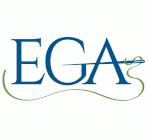 |
Needle Arts Guild of ToledoA member Chapter of the Great Lakes Regionof The Embroiderers' Guild of America, Inc.. |
 |
|
|
Evaluating Your Embroidery - PresentationThe following article was written by Cathy Studer in 2004 for the newsletter
of the Needle Arts Guild of Toledo. In this category the judge will look at how well your embroidery is presented. The quality of the finishing as well as how well the finishing enhances your embroidery are important here. One of the first things you want to check is the cleanliness of your work. Watch for creases, hoop marks, fuzzies and animal hair. Block or press your work before finishing, being careful to keep the grain of your fabric straight and watch out for any distortion. If you are finishing your item into a bell pull, pillow or other object that will have fabric sewn around the embroidery be sure that the grain of this fabric is also straight. Use only fabric that will enhance your embroidery, not detract from it, you want the stitched area to be the focal point. In all types of finishing no carry threads, knots or extra bulk from the back of the embroidery should be visible through the fabric. A good way to hide extra bulk on the back when framing is to pad your embroidery with a half-layer of thin batting. This will absorb the extra bulk without puffing up your embroidery. Items that are finished with machine sewing, such as pillows, tote bags and purses, should show good machine sewing technique. Crooked seams, zippers and fabric will detract from a beautiful piece of embroidery. If hand sewn techniques are used such as in three dimensional objects, needle cases, and ornaments, all hand stitching should be invisible. When stuffing items such as pillows and dimensional items, be sure that all areas and corners are sufficiently filled so that you don't have any "dog ears" or creases. Be sure your stuffing is smooth and not lumpy. When framing, please consider using a professional needlework framer. It may be expensive, but inexperienced framing techniques can detract from your needlework. Be sure not to over-do the framing. You don't want your mats or frames to draw your eye away from your embroidery, you want them to lead you into it. An ornate frame or many layers of mats will draw your eye to the framing instead of the embroidery. Carefully planning the finishing of your needlework is just as important as the planning of the embroidery itself. Finishing can enhance or detract from a beautiful piece of needlework. Look at other finished pieces and observe what you like or dislike about how they are finished. Ask others for their opinions and advice. By observing and asking you may get ideas you had never thought of. This page was last updated on September 24, 2018. |
|